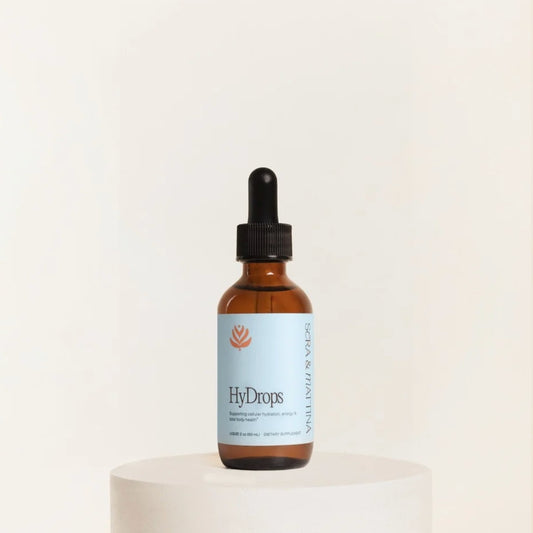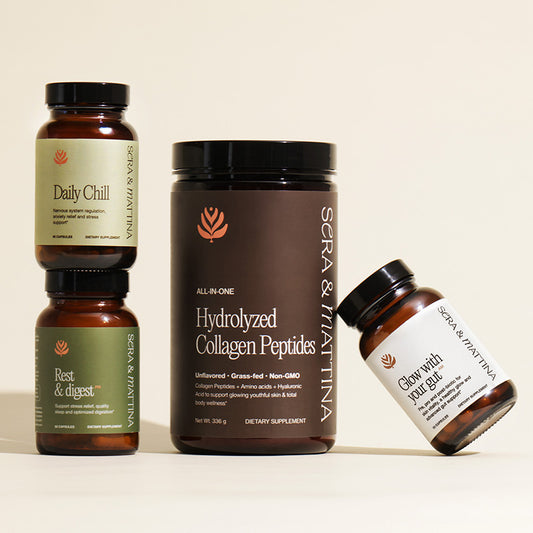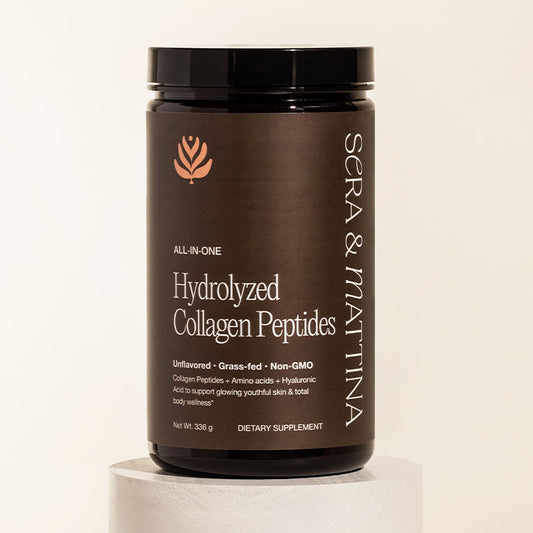If you’ve ever noticed your skin breaking out after a stressful week or glowing when you’re eating well, you’ve seen the gut-skin axis in action. The gut skin axis is the scientific term for the two-way connection between your digestive system and your skin.
This connection is mediated by the gut microbiome, or the trillions of bacteria, fungi, and other microbes in your digestive tract. When your gut is balanced and healthy, it can help keep your skin looking vibrant and clear. But when the gut is inflamed or imbalanced, the effects often show up on your skin.
And while probiotics are often at the center of the gut-skin conversation, they’re not the only player. Collagen also plays a role in supporting both gut health and skin appearance.
Understanding the Gut-Skin Axis
The gut skin axis is a complex communication network involving:
- The immune system
- Hormones and signaling molecules
- Metabolites produced by gut bacteria
-
The skin’s own microbiome
In a healthy state, the gut and skin help maintain each other’s balance. The gut processes nutrients that keep skin cells strong, while the skin acts as a protective barrier. But if the gut skin connection is disrupted, inflammation can increase, affecting both organs.
How Gut Health Influences Skin
Your gut is home to a vast ecosystem of microbes that help digest food, produce vitamins, and protect against pathogens. When the balance of these microbes known as the gut microbiome is disrupted, it’s called dysbiosis.
Research links gut dysbiosis to a range of skin conditions, including:
- Acne vulgaris
- Atopic dermatitis (eczema)
- Psoriasis
- Rosacea
-
Premature skin aging
One proposed mechanism is that an imbalanced gut can damage the intestinal barrier (sometimes called “leaky gut”), allowing pro-inflammatory molecules to enter the bloodstream. This systemic inflammation can trigger or worsen skin issues (Salem et al., 2018).
Nutrient absorption is another factor. The gut is responsible for absorbing amino acids, antioxidants, essential fatty acids, and vitamins which are all building blocks for healthy skin. When gut function is compromised, the skin may not get the nutrients it needs to repair and regenerate.
The Role of Probiotics in Skin and Gut Health
Probiotics are beneficial live bacteria that can help restore balance to the gut microbiome. They support the gut health and skin relationship in several ways:
-
Reducing inflammation: Certain probiotic strains reduce pro-inflammatory cytokines, lowering systemic inflammation that can affect skin (Bowe & Logan, 2011).
-
Strengthening the gut barrier: Probiotics help maintain tight junctions between intestinal cells, preventing unwanted particles from entering circulation.
-
Balancing the skin microbiome: Some probiotics can influence the composition of bacteria on the skin itself, which may help reduce acne and dermatitis.
-
Supporting hydration and elasticity: A randomized controlled trial found that oral intake of Lactobacillus plantarum improved skin hydration and reduced wrinkles (Lee et al., 2015).
Emerging research also suggests that probiotics may help regulate sebum production and oxidative stress, both important for clearer, healthier-looking skin.
Collagen and the Gut-Skin Axis
While probiotics get most of the attention in the gut-skin conversation, collagen is another key player.
Here’s how collagen fits in:
-
Gut barrier integrity: Hydrolyzed collagen contains amino acids like glycine, proline, and hydroxyproline, which support the structural proteins in the gut lining. A healthy gut lining prevents excess inflammation, which can benefit skin clarity.
-
Reduced inflammation: Collagen peptides may indirectly lower skin inflammation by maintaining gut barrier function.
-
Direct skin benefits: Multiple clinical studies show collagen peptides improve hydration, elasticity, and reduce fine lines (Proksch et al., 2014).
Collagen’s dual action of strengthening the gut barrier and enhancing skin structure makes it a perfect complement to probiotics for full gut-skin axis support.
How to Support the Gut-Skin Axis with Nutrition
Maintaining a balanced gut and healthy skin involves a holistic approach:
-
Eat a diverse, fiber-rich diet to feed beneficial gut bacteria.
-
Include probiotic-rich foods like yogurt, kefir, kimchi, and sauerkraut.
-
Add hydrolyzed collagen peptides to support both gut lining and skin.
-
Stay hydrated to help maintain skin plumpness and gut motility.
-
Avoid excess sugar and ultra-processed foods, which may promote dysbiosis.
- Manage stress and get enough sleep, as both directly affect gut microbiota and skin health.
Support Your Gut and Skin with Sera & Mattina
At Sera & Mattina, we believe optimal wellness starts in the gut and it shows on your skin. Our Collagen Peptides are made with hydrolyzed collagen for maximum absorption, delivering the amino acids your gut lining and skin need to stay strong and resilient.
When paired with a quality probiotic routine and skin-friendly nutrition, collagen can help you maintain the balance your gut and skin need to thrive.
References
-
Salem, I., Ramser, A., Isham, N., & Ghannoum, M. A. (2018). The gut microbiome as a major regulator of the gut-skin axis. Frontiers in Microbiology, 9, 1459. https://doi.org/10.3389/fmicb.2018.01459
-
Bowe, W. P., & Logan, A. C. (2011). Acne vulgaris, probiotics and the gut-brain-skin axis — back to the future? Gut Pathogens, 3(1), 1. https://doi.org/10.1186/1757-4749-3-1
-
Lee, D. E., Huh, C. S., Ra, J., et al. (2015). Clinical evidence of effects of Lactobacillus plantarum HY7714 on skin aging: A randomized, double-blind, placebo-controlled study. Journal of Microbiology and Biotechnology, 25(12), 2160–2168. https://doi.org/10.4014/jmb.1509.09021
- Proksch, E., Schunck, M., Zague, V., et al. (2014). Oral intake of specific bioactive collagen peptides reduces skin wrinkles and increases dermal matrix synthesis. Skin Pharmacology and Physiology, 27(3), 113–119. https://doi.org/10.1159/000355523







